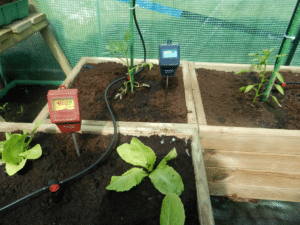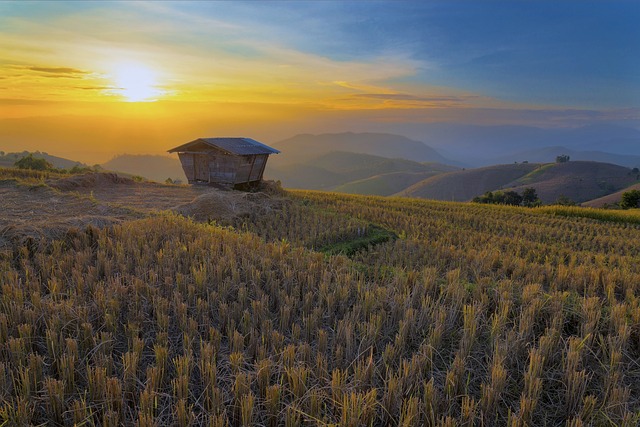Introduction – Drip Irrigation as An Alternative To Sprinklers
A drip irrigation system is a process of slow, controlled delivery of water, exactly where it is required, to each plant in the field. Drip irrigation technology was first developed for agricultural uses around 1940 to deliver water to plants.

Drip Irrigation Is Used For 9% Of Agriculture
Drip irrigation, a form of microirrigation, channels water directly to a plant’s root zone using perforated pipes, which minimizes evaporation and waste. This efficient method is particularly beneficial for high-value crops and can be employed on uneven terrains.
In 2015, the U.S. had 63,500 thousand acres under irrigation, of which approximately 5,490 thousand acres were served by drip/microirrigation systems. This means that nearly 8.6% of the irrigated land in the U.S. utilized this sustainable irrigation method during that year.
For Home Use – Above And Below Ground
Drip irrigation is also used in home gardens. Although originally used exclusively for agriculture, drip irrigation has since been adapted and applied to almost all horticultural practices, including forestry and landscaping work.
You can apply the process both above ground and below ground. Above-ground drip irrigation is relatively common, often in the form of a hose connected to emitters attached to the base of each plant.
This can be very effective for horticultural uses where plants are usually not spaced too far apart, allowing water to reach deep roots without causing root rot. The technology works especially well with fast-growing plants that require frequent watering during hot weather.
How Much Water Does A Drip System Save?
The answer depends on the specific system, the type of plants being watered, and weather conditions. Studies have shown that using a drip irrigation system can result in a 60% reduction in water usage compared to traditional sprinklers.
This targeted approach allows for more efficient water use and reduces evaporation and runoff. In addition, drip systems can be programmed or manually controlled for precise watering schedules, helping to conserve water further.
The Main Benefits Are Reduction Of Water Waste
The main benefit of drip irrigation is that it greatly reduces water waste. Traditional methods of sprinkling or flooding an entire field with water often waste huge amounts of water through evaporation and runoff.
With drip irrigation, you can control where the water goes and how much at a time. This allows farmers to conserve as much water as possible while ensuring healthy plant growth.
Another way drip irrigation conserves water is by using low-pressure emitters that release very small droplets of water directly onto the roots of plants instead of continuously spraying them with large jets of water like traditional sprinkler systems do. This prevents any unnecessary runoff or evaporation, thus reducing waste even further.
Another benefit of drip irrigation is that it can be automatically controlled and monitored, reducing the need for manual labor. This makes it an especially efficient solution for large-scale agricultural applications.
Overall, drip irrigation is a very effective method for conserving water while optimizing plant growth, making it a great choice for those looking to reduce their environmental footprint.
Considerations For Installing Drip Irrigation
The first step in setting up a drip irrigation system is to plan out the layout, considering the placement of plants and any obstacles in the area. Next, emitters or drippers are attached to the main water source and placed near each plant’s root zone.
Once all the tubing has been laid out and connected, you can turn the system on to provide slow, targeted irrigation. Regular maintenance, such as cleaning clogged emitters and adjusting water flow, helps ensure that the plants receive adequate water without waste.
Product Spot-Light: Eve Aqua – Smart Water Controller for Apple Home app or Siri
This device allows you to automate irrigation in your garden or on the terrace. With the Eve Aqua smart water controller, you can activate your irrigation system via your iPhone, Siri, or the onboard button.
You can also set up schedules to let Eve Aqua water your garden and patio plants automatically without requiring an internet connection, a bridge, or a gateway.
The device is built to be durable with IPX4 water resistance and UV protection. It’s compatible with all popular hose systems and multi-channel water distributors. The Eve Aqua also supports Thread, making your smart home faster and more reliable. The product is priced at $149.95.
Types Of Drip Irrigation
Drip irrigation is a type of irrigation that efficiently delivers water directly to the roots of plants. There are several drip irrigation systems, each with advantages and benefits.
Micro-Drip
One type, called micro-drip irrigation, delivers water through small tubing with emitters spaced along the line to deliver precise amounts of water exactly where it’s needed.
Soaker Hose
Another option is a soaker hose, which gradually releases the water along its length to provide even coverage in areas without precise planting patterns. Laterals are long narrow hoses connected to a mainline and fitted with small emitters at regular intervals, making them well-suited for large fields or lawns.

Despite varying designs and functions, all types of drip irrigation help conserve water by delivering it directly to the plants’ roots instead of letting it evaporate or run off.
In addition, they can reduce weed growth and improve plant health by providing consistent moisture levels and reducing fungus caused by excess moisture on leaves and stems. Drip irrigation truly offers solutions for efficient water usage in any garden setting.
Conclusions
In conclusion, drip irrigation is a highly efficient and customizable method of delivering water directly to the roots of plants. There are several different drip irrigation systems, each with its benefits and advantages.
Whether used in agricultural settings or home gardens, investing in a drip irrigation system can lead to healthier plants and saved resources in the long run.
Not only does it help conserve water by targeting specific areas instead of wasting it on evaporation, but it can also improve plant health by reducing unwanted moisture on leaves and stems. Whether used for home gardening or large-scale farming, investing in a drip irrigation system can lead to significant water savings over time.
